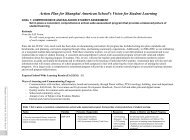Curriculum and Instruction - SAS-WASC
Curriculum and Instruction - SAS-WASC
Curriculum and Instruction - SAS-WASC
You also want an ePaper? Increase the reach of your titles
YUMPU automatically turns print PDFs into web optimized ePapers that Google loves.
<strong>Curriculum</strong> <strong>and</strong> <strong>Instruction</strong>The ProcessTeachers across both campuses – in all subject areas <strong>and</strong> at all grade levels – workedcollaboratively to gather data <strong>and</strong> respond to the guide questions that form the basisof the curriculum <strong>and</strong> instruction portion of the self study.They had plenty of challenges. Rapid growth at <strong>SAS</strong>, as we entered our self study,was key among those challenges. Three of six principals were new to the region <strong>and</strong>to <strong>WASC</strong> processes. Over 90 faculty members were new to the school. One goal wasto help those new-hires become familiar with <strong>SAS</strong> curricular expectations throughthe self study process. To that end, team <strong>and</strong> department teacher leaders played aninstrumental role. They attended facilitator seminars that allowed the educationalprograms office to ensure that instructions were consistent, that teacher leaders hadexemplars for creating team norms <strong>and</strong> for protocols that made looking at studentlearning productive <strong>and</strong> positive. This was most successful where principals or viceprincipals were full participants in the seminars.Note: For more information about how we help new faculty come on board with <strong>SAS</strong>curriculum, please see new hire mentor materials in the Appendix.Because of the size of the school, the volume of data collected, <strong>and</strong> the desire forevery teacher to be involved, it was decided to house as much data on Atlas as wecould. Many teachers posted their evidence <strong>and</strong> notes from discussions on Atlas;this resource is important to underst<strong>and</strong>ing our progress in the area of curriculumdevelopment <strong>and</strong> documentation. That said, since full uploading of the curriculumonto Atlas is not yet complete, <strong>and</strong> because not all teachers are fully comfortablewith the analysis functions of Atlas, this data source is supported by a hard copySubject Area Evidence Binder. These binders for each subject area can be found inthe evidence room on each campus <strong>and</strong> with each subject area teacher leader.The Subject Area Evidence Binders include the following:1. Sources of the recently adopted st<strong>and</strong>ards <strong>and</strong> benchmarks2. Atlas audit of the units completed for the subject area – by grade level3. Areas for strength <strong>and</strong> areas for follow-up identified by teachers in theirsubject area groups4. The continuum that guided conversations about progress along thecontinuum towards best practice, identifying areas of strength <strong>and</strong> areas forfollow-up. Continuum items include:• <strong>WASC</strong> guide questions• Essential teaching agreements, based on best practice, thatteachers have written for grade levels inelementary school grade level teams <strong>and</strong>for subjects under program review• Selected NSSE Quality Schools items5. Data considered for the discussions, including:• Student <strong>and</strong> Community Profile (with ITBS, ERB, SAT <strong>and</strong>other data)• NSSE survey data• Atlas analysis of assessment types• Atlas analysis of EAGLES coverage• Assessment data templates• Sources of assessment• How students learn templates• Artifacts of learningShanghai American School Self Study Report 73



